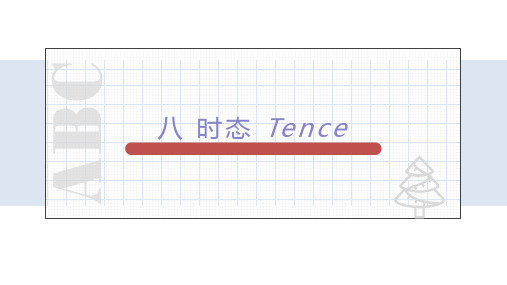初中英语时态专题讲解PPT课件
合集下载
初中英语八种时态讲解-课件PPT

什么情况下用?
①表示经常或习惯性的动作或存 在的状态。②表示主语通常的能 力、兴趣爱好、和性格特征。③ 表示客观的事实或真理。④表示 按照时刻表或已经计划安排好的 将来行为。(只限于是go, come, leave, arrive, begin, start, take off, stop, be等表示开始或移动意义的 词。)⑤在时间状语从句和条件 状语从句中,主句用一般将来时 (will+动词原形),从句中用一般
变“y”为“i”再加-ed
worry→worried
cry→cried
1. He____(be, was, were, been) here a moment ago. 2. They ____(be, was, were, been) here just now. 3. The scientists _____(leave, leaves, leaved, left) for America yesterday. 4. Last week we ______(visit, visited ) the Science Museum. 5. When I was a child, I often ____(play, played) football. 6. The students ran out of the classroom as soon as the bell ____(ring, rang, rung).
一般过去时
概念:过去某个时间里发生的动作或 状态;过去习惯性、经常性的动作、 行为。 时间状语:ago, yesterday, the day before yesterday, last week(year, night, month…), in 1989, just now, at the age of 5, one day, long long ago, once upon a time, etc. 基本结构:①be动词;②行为动词 否定形式:①was/were+not;②在行为 动词前加didn't,同时还原行为动词。 一般疑问句:①was或were放于句首; ②用助动词do的过去式did 提问,同时 还原行为动词。
初中英语六种时态复习课件(35张PPT)

②while 引导的从句表示“在……期间”,主从句谓语动词所表示的动 作同时ቤተ መጻሕፍቲ ባይዱ生。这时,主从句都用过去进行时。
e.g.:My father was reading the newspaper while my mother was watching TV.当我的妈妈看电视的时候,我的爸爸正在看报纸。
(2)表示普遍真理或客观事实。 e.g.:The sun rises in the east.太阳从东方升起。 (3)在条件状语从句和时间状语从句中,用一般现在时表示将来。 e.g.:If it doesn't rain tomorrow,we will go for a picnic.如果明天不下 雨,我们将去野餐。 (4)在某些以 here,there 开头的句子中用一般现在时表示正在发生的动作。 e.g.:There goes the bell.铃响了。
(3)现在进行时表示将来 表示位置移动的动词 go,come,leave,fly,start,meet,move 等, 可以用现在进行时表示将要发生的事。 e.g.:We are leaving for London.我们就要动身去伦敦了。
(4)一般现在时表示将来 ①表示按规定或时间表预计要发生的动作。 e.g.:Our plane takes off at 8:10.我们的飞机 8:10 起飞。 ②当主句为一般将来时,或含有情态动词,或是祈使句时,在 if,as soon as,until,when 等引导的状语从句中用一般现在时表示将来。 e.g.:I will give him the book as soon as he comes here.他一来这儿, 我就把这本书给他。
(2)表示当前一段时间内的活动或现阶段正在进行的动作。 e.g.:They are picking apples on a farm all the time.他们一直在农场 摘苹果。 (3)与 always,usually 等词连用,表达说话人强烈的感情,如赞扬、不 满、讨厌等。 e.g.:Mary is always thinking of others instead of herself.玛丽总是为 别人着想,而不为自己着想。
16种英语时态讲解PPT课件

• I have worked in this company since 1980.
2) for+时间段
• Great changes have taken place in Changsha for the past few
years. 3) “到目前为止…”:until now, up until now, up to now, up till now,
用法2: 表示过去一段时间一直持续或反复发生的动作. • He used to do morning exercises. • I lived in the country for ten years. • He took a walk after supper when he was alive.
• He always goes to school by bike.
9/13/2019
3
二、一般现在时态
一般现在时的基本用法
用法2: 表示不受时间限制的事实陈述或客观性的真理. • The earth moves around the sun. • The sun rises in the east and sets in the west. • Knowledge is power.
用法2: 表示现阶段正在持续的动作,说话时刻动作 不一定正在发生.
• These days I am translating a book.
• I am feeding the neighbor’s cat this week while she’s in hospital.
• Mr. Green is writing another novel.
时态
Tense
初中英语七种时态 初中英语语法 教学PPT课件

1.改为一般疑问句并回答。 Are you doing your homework now? Yes, I am./No, I'm not. 2.改为否定句。
I am not doing my homework now.
五、过去进行时 1.过去进行时:表示在过去某一时刻或某一阶
段正在进行的动作。
2.常用时间状语: at that time, at 8:00 last
4)表示客观真理,客观存在,自然现象。 例如:The earth moves around the sun.
地球绕太阳转动。
I do my homework every day.
1.改为一般疑问句并回答。 Do you do your homework every day? Yes, I do./No, I don't. 2.改为否定句。
2.过去进行时的用法:
表示在过去某时刻正在进行或发生的动作,通常与表 示过去的时间壮语连用。
例如:At this moment yesterday, I was packing for camp. 昨天这个时候间壮语从句的复合句中,表示一个过去的 动作发生时或发生之后,另一个动作正在进行。
close
sit begin run put
lie die tie
-ing形式
listening spending staying
having preparing
closing
sitting beginning running
putting
lying dying tying
I am doing my homework now.
like live
plan stop drop
I am not doing my homework now.
五、过去进行时 1.过去进行时:表示在过去某一时刻或某一阶
段正在进行的动作。
2.常用时间状语: at that time, at 8:00 last
4)表示客观真理,客观存在,自然现象。 例如:The earth moves around the sun.
地球绕太阳转动。
I do my homework every day.
1.改为一般疑问句并回答。 Do you do your homework every day? Yes, I do./No, I don't. 2.改为否定句。
2.过去进行时的用法:
表示在过去某时刻正在进行或发生的动作,通常与表 示过去的时间壮语连用。
例如:At this moment yesterday, I was packing for camp. 昨天这个时候间壮语从句的复合句中,表示一个过去的 动作发生时或发生之后,另一个动作正在进行。
close
sit begin run put
lie die tie
-ing形式
listening spending staying
having preparing
closing
sitting beginning running
putting
lying dying tying
I am doing my homework now.
like live
plan stop drop
初中英语中考复习时态讲解课件(共79张ppt)

一般现在时
1. 表示经常性或习惯性的动作
She does excersice everyday.
真题链接
—What do you often do at weekends?
—I often ____ my grandparents.
A. visit
B. visited
C. have visited D. will visit
Just a moment, I am washing dishes.
when
习题
Just a minute! My brother________ his car in the garden. A. washes B. is washing C. washed D. will wash
习题
---Hey, Tom. Let’s go swimming.
动词过去分词 不规则变化
speak hear see give build swim buy teach
spoken heard seen given built swum bought taught
现在完成时
already yet
1.过去发生或已完成的某一动作对现在的影响。
I have already watched this film. I haven't watched this film yet. I have already visited America. I haven't visited America yet.
A. prepares
B. is preparing
C. has prepared D. prepared
真题链接
--Mum, it's late. Why are you still here? --Dad hasn't come back yet. I ____ for him. A. am waitingB. was waiting C. waited D. had waited
初中英语八大时态课件(共77张PPT)

exercise
把下列句子改为一般疑问句
1.He has a meeting on Sundays . Does he have a meeting on Sundays ?
2.He goes to school at seven in the morning . Does he go to school at seven in the morning?
2. 当 主 语 是 单 数 第 三 人 称 时 , 它与助动词Does有关,但是 动词谓语一定要恢复为原形。 当主语是其他人称时,它与 助动词Do有关。
I like English. She likes it very much. We go to work by bike.
否定句
I don’t like English.
3.My father and mother go out for lunch on Sundays. Do your father and mother go out for lunch on Sundays ?
4.We do our homework after school.
Do you do your homework after school ?
2) I will return home as soon as I finish my task.
2、be going to + v原形
①表示打算做某事 ②表示现在已经有迹象表明将要发生某事。
--- What __a_re__y_o_u__g_o_in_g__t_o_do this evening? --- I am going to do my lessons.
Review of Tenses
初中英语-时态系列PPT课件

做题时常见错误
心得体会: 在一般现在时的做题过程中,常常
会出现一下五种做题错误.
一、be动词与行为动词同时出现在句子中 . 二、单三人称形式易出错 .
三、在句式变换时易出错.
四、对do的理解易出错 . 五、对主语的数判断有误 .
做题时常见错误一、be动词与行为动词同时出现在句子中 .
例:根据动词填空 We ___ ____ (plant) the trees in spring. 正确答案:plant 错误答案: are plant 解析: 学生往往会用汉语的思维方式去翻译,就
4 He said the sun ____in the east and ____in the west.
A rose; set B rises; sets C rises, set D rise; sets
5 Wang Mei ____ music and often ____ to music.
gos 解析: 1:以辅音字母加y结尾的动词变单三人称形式
才能把y换成i再加es; 2:与名词变复数不同,变单三人称形式以o结
尾的词要加es.
做题时常见错误 三、在句式变换时易出错
三、在句式变换时易出错
例:根据动词完形填空
1 ____Jenny ____ (has) a good friend?
变一般疑问句须在句首加助动词do。
例如:They have lunch at 12:00. 陈述句
他们在12:00吃午饭。
They don’t have lunch at 12:00. 否定句
他们不在12:00吃午饭。
Do they have lunch at 12:00? 一般疑问句
初中英语八种时态解PPT课件

什么情况下用?
①表示经常或习惯性的动作或存 在的状态。②表示主语通常的能 力、兴趣爱好、和性格特征。③ 表示客观的事实或真理。④表示 按照时刻表或已经计划安排好的 将来行为。(只限于是go, come, leave, arrive, begin, start, take off, stop, be等表示开始或移动意义的 词。)⑤在时间状语从句和条件 状语从句中,主句用一般将来时 (will+动词原形),从句中用一般
1. He______(be, am, is, are) a teacher at No. 2 Middle School. 2. He______(have, has) classes in the afternoon. 3. He______(get, gets) up at half past six every morning. 4. He always _____(come, comes ) to school on time. 5. He ______(study, studies) very hard at his lesson. 6. One and two _____(be, is, are) three. 7. Blue and yellow _____(make, makes) green. 8. The earth _____(move, moves) round the sun. 9. I will go there if I ____( be, will be, am, is, are) free tomorrow.
初中英语八种时态解
一般现在时 一般过去时 现在进行时 过去进行时 现在完成时 过去完成时 一般将来时 过去将来时
一般现在时
一、一般现在时:
初中英语语法—时态(28张) PPT课件 图文

(4)现在完成时与表示一段时间的for短语、since短语或从句等 时,应注意句中的谓语动词须是延续性的,而不能是非延续性动词,如 come→be here,go→be there,die→be dead,borrow→keep,buy→h ,join→be in,leave→be away,begin to study→study等。
6.过去进行时
(1)概念:表示过去某一时刻或某一时间段内正在进行的动作。 (2)构成形式:was/were+动词的-ing形式 ①表示往返、位移的动词的过去进行时常可用来表示过去将来时
时态 We wanted to tell her that the train was_leaving an hour later.
1.一般现在时
基本用法: (1)表示经常性、习惯性的动作; He always helps others. 他总是帮助别人。
时态 (2)表示现在的情况或状态;
He is a teacher. 他是个老师。 (3)表示客观事实和普遍真理。 The sun rises in the east. 太阳从东边升起。 构成形式:am/is/are或实义动词的原形(主语是第三人称单数时,动 词要用第三人称单数形式)。
时态 (2)构成形式:have/has+动词的过去分词。
(3)与现在完成时连用的时间状语有for a long time,recently,yet, lately,ever,never,already,since,by this time,before,just,in t past/last few years,since+过去的时间点,since+时间段+ago,since +从句(一般过去时)。
表示感觉的动词。如:see,hear等。 表示喜欢或厌恶的动词。如:like,love等。 表示希望的动词。如:want,would like等。
初中英语动词八大时态讲解PPT课件

疑问找助动词:do, does
否定找助动词:don’t ,doesn’t
.Hale Waihona Puke 3二、一般过去时 1、be 式动词:
was were 一般过去时 2、实义动词: 使用动词的过去式 (分为规则与不规则) 疑问否定:. did, did’t 4
三 、现在进行时
Is / am /are + doing (注意现在分词的构成)
六、过去完成时:过去的过去
在过去某时间(或动作)看来已经
完成了的动作 :had + done
常见的句型:
①过去完成时 + by the time …
②过去完成时 + by the end of+ 过去的时间
③过去完成时+ when + 一般过去时的句子
④过去完成时+ before + 一般过去时的句子
1、直接+ing
2、去掉e,+
ing
现在进行 时
3、双写+ing
.
5
四、过去进行时 过去进行时
was / were + doing
注意过去进行时与一般过去时的
区别:
1、意义上:过去进行时指过去某
点或某段时间正在进行的动作;而
一般过去时指在过去的时间里所
发生事实。
2、动词使用的形式. 不同
6
五、现在完成时 1、have/ has + done (动作发生在过去对现在造成的 结果或影响) 2、常见的时间状语或句型 ①already,just,ever,never,yet
考点:主句为一般将来时,从句(条件)
用一般现在时。
•We will not go out if it snows tomorrow.
初中英语语法课件ppt

vacation together.
过去将来时的使用:
一、过去将来时表示对于过去某一时间而言将要发生的动 作或存在的状态。 would或was /were going to + V
would可用于各种人称。
二、would +V还可表示过去的习惯动作,在这点上同used to同义。
When we were children, we would/used to go swimming every summer.
e) 用于条件从句“如果……想,设想”(接近if ……want to,或 if ……should) 例:Greater efforts to increase agricultural production must be made if food shortage ____________ avoided. A) is to be B) can be C) will be D) has been
一般现在时的动词形式: 动词原形 1.am;is ;are 2.have,has 3.第三人称单数形式-(e)s
肯定句:I watch television every day.
否定句:I don’t watch television every day.
疑问句:Do you watch television every day.
一般现在时的使用:
1.一般现在时表示总是、通常、习惯 性的动作或状态。
It snows in winter. I watch television every day.
2.用于对客观事实的普遍性的陈述。
Water consists of hydrogen and oxygen. Most animals kill only for food. The world is round.
过去将来时的使用:
一、过去将来时表示对于过去某一时间而言将要发生的动 作或存在的状态。 would或was /were going to + V
would可用于各种人称。
二、would +V还可表示过去的习惯动作,在这点上同used to同义。
When we were children, we would/used to go swimming every summer.
e) 用于条件从句“如果……想,设想”(接近if ……want to,或 if ……should) 例:Greater efforts to increase agricultural production must be made if food shortage ____________ avoided. A) is to be B) can be C) will be D) has been
一般现在时的动词形式: 动词原形 1.am;is ;are 2.have,has 3.第三人称单数形式-(e)s
肯定句:I watch television every day.
否定句:I don’t watch television every day.
疑问句:Do you watch television every day.
一般现在时的使用:
1.一般现在时表示总是、通常、习惯 性的动作或状态。
It snows in winter. I watch television every day.
2.用于对客观事实的普遍性的陈述。
Water consists of hydrogen and oxygen. Most animals kill only for food. The world is round.
初中英语语法时态(共25张PPT)

A.goes B.will go
C.would go D.are going
2.--Did your son fail his English exam once again?
--Yes, but he told me he____hard next term.
A.studies B.is studying C.will studyD.would study
2 have been to+地点,表示“去过某
地”。(人已回) I have been to Europe. (I am not in Europe now.)
3 have been in+地点+时间段,表示“在/ 来某地多久”。
I have been in Europe for three weeks. (I am now still in Europe .)
3.现在完成时和一般过去时的异同点: 1 共同点:动作都在过去。 2 不同点:和现在有无关系。(与现
在有关的过去动作用现在完成,与现在 无关的过去动作用一般过去。)
4.易错点:
1 have gone to+地点,表示“去了某地”。
(人已走,尚未回。只用于第三人称。)
They have gone to Europe. (They are not here.)
C.didn’t he
D.did he
三、现在进行时
1.用法:
A.现刻动作:目前正在发生的动作。
B.现阶段动作:目前一个时期一直在进 行的动作,此刻不一定在进行。
2.标志词:now,Look! Listen!
中考模拟:
--Mike, who____football in the yard?
初中英语八大时态讲解_图文

2 have been to+地点,表示“去过某地”
。(人已回) I have been to Europe. (I am not in Europe now.)
3 have been in+地点+时间段,表示“在/ 来某地多久”。
I have been in Europe for three weeks. (I am now still in Europe .)
go there get home open close get to know borrow buy
be there be home be open be closed know keep have
1.The film began 5 The film_h_a_s b_e_en_o_n__ for 5
• 9.They got to know 10 They_h_av_e_k_n_o_w_n__since 10
years ago.
years ago.
• 10.I borrowed the book a I_h_a_v_e _k_e_p_t _the book for a
week ago.
week.
二、一般过去时
1.用法:过去的动作或状态。
2.标志词:
yesterday, the day before yesterday,
three days ago, last night/week/month…,in the past;just
now=a moment ago
例题
Li Ming didn’t understand what American people
4.He joined the club 3 He__h_as_b_e_en_i_n__the club for
初中英语语法:时态(共47张PPT)

一般现在时
表示经常的或习惯性的动作 常与表示频率的时间状语连用
LOGO
always,usually,often,sometimes
every morning/night/evening/day/week/year
once a month,twice a week three times a day hardly ever,seldom,never
变-ed(过去式/过去分词)
LOGO
注意:以上只是规则变化
变 - e d(过去式 / 过去分 词) 不规则变化
LOGO
原型 过去式 过去分词
变-ed(过去式/过去分词)
LOGO
原型 过去式Biblioteka 过去分词一般过去时 LOGO
一般过去时 LOGO
yesterday(morning,afternoon,evening) the day before yesterday last night (week,Sunday,weekend,month,winter,year,century ) ago the other day -- a few days ago. this morning/afternoon/evening just now at the age of 10 (过去年龄段) in the old days at that time in the+整十数年份+s(⋯世纪⋯年代) used to do... (过去做...)
(不常)
(几乎不) (从不)
在答句中,频率副词必须放在助动词前 Do you often go there?
(误)Yes, I do often. (正)Yes, I often do. Sometimes I go to school by bus. 我有时坐公交车上学。 I go to school by bike usually. 我通常骑车上学。
英语时态讲解课件.ppt

(2)现在完成时表示过去已经开始,持续到现在,也许还会持续下 去的动作或状态。可以和表示从过去某一时刻延续到现在(包括现 在在内)的一段时间的状语连用。 如:for和since,以及 so far, now, today, this week(month, year) 等。
① I haven’t seen her these days. ② She has learnt English for 3 years. ③ They have lived here since 1990. ④ What has happened to the USA in the last 350 years? 注意:表示短暂时间动作的词,如come, go, die, marry, buy等的完 成时不能与for, since等表示一段时间的短语连用。
-ing形式 going, looking
writing, taking
get, sit, put, run, getting, sitting,
begin
running,
beginning
现在完成时
1.现在完成时的构成:助动词have (has) + 动词的过去分词(done)
2.现在完成时的用法: (1)现在完成时表示过去发生或已经完成的某一动作对现在造成 的影响或结果。通常与表示包括现在在内的时间副词just,already, before, yet, never, ever ,up till now 等状语连用。 特别注意的是in the past/last+一段时间。 例如:
A. had met B. have met C. met
D. meet
答案B ;首先本题后句强调对现在的影响,我知道她的模样,你不 用描述。再次,several times告知为反复发生的动作,因此用现在 完成时。
初中英语动词时态讲解 (共37张PPT)

2.
系动词只和形容词连用,构成系表结构
1) 2) 3)
实义动词
1. 2.
3.
实义动词指的是有具体行为意思的动词。 实义动词在句中可以做谓语动词和非谓语 动词。 做谓语动词的用法 动词会有四种形式:单三,现在分词,过 去式,过去分词
实义动词
注意:掌握四种形式的变化规律 1) He works in the office. 2) We are dancing together. 3) I caught a cold last week. 4) She has watered the flower.
want to do decide to do plan to do would like to do learn to do tell sb.( not)to do ask sb.(not) to do
实义动词
注意下列词不同形式的不同用法: 注意下列词不同形式的不同用法: remember doing/to do forget doing/to do stop doing/to do go on doing/to do
实义动词
4.
做非谓语动词的用法(指出现在谓语动词 之后的动词,它受前面谓语动词的限制) 动词会有三种形式:
1) 2) 3)
原型(do) 原型(do) 动名词(doing) 动名词(doing) 不定式(to 不定式(to do)
实义动词
1)
用原型:
a) b) c) d)
let sb.do make sb.do help sb.(to)do had better do
一般将来时
一般将来时表示将来发生的动作或存在的状态 结构: 助动词shall/will + 动词原形(shall一般用 助动词shall/will 动词原形(shall一般用 于主语是第一人称时, Will是英语任何主语。) Will是英语任何主语。) 肯定式:主语+shall/will+动词原形+ 肯定式:主语+shall/will+动词原形+其他 否定式:主语+shall/will+not+动词原形+其他. 否定式:主语+shall/will+not+动词原形+其他. 疑问式:Shall/Will+主语+动词原形+ 疑问式:Shall/Will+主语+动词原形+其他 简略回答:(肯)Yes,主语+shall/will 简略回答:(肯)Yes,主语+shall/will . (否)No,主语+shall/will+not … )No,主语+shall/will+not 缩写形式: 缩写形式: 'll ==shall/will shan't== shall not won't == will not
- 1、下载文档前请自行甄别文档内容的完整性,平台不提供额外的编辑、内容补充、找答案等附加服务。
- 2、"仅部分预览"的文档,不可在线预览部分如存在完整性等问题,可反馈申请退款(可完整预览的文档不适用该条件!)。
- 3、如文档侵犯您的权益,请联系客服反馈,我们会尽快为您处理(人工客服工作时间:9:00-18:30)。
初中语法专题(一)
1
整体概况
+ 概况1
您的内容打在这里,或者通过复制您的文本后。
概况2
+ 您的内容打在这里,或者通过复制您的文本后。
概况3
+ 您的内容打在这里,或者通过复制您的文本后。
2
一般现在时 一般过去时 现在进行时 过去进行时 现在完成时 过去完成时 一般将来时 过去将来时 3
一般现在时
4
一、一般现在时:
概念:经常、反复发生的动作或行为及现在的 某种状况。 时间状语: always, usually, often, sometimes, every week (day,
year, month…), once a week, on Sundays, etc.
基本结构:①be动词;②行为动词 否定形式:①am/is/are+not;②此时态的谓语动 词若为行为动词,则在其前加don't,如主语为第 三人称单数,则用doesn't,同时还原行为动词。 一般疑问句:①把be动词放于句首;②用助动 词do提问,如主语为第三人称单数,则用does, 同时,还原行为动词。
14
谓语动词使用过去式形式, 加ed,分为规则和不规则变 化。表示过去经常发生的动 作,也可用“used to do ” 和“would +动词原形”。
15
构成规则
例子
一般在动词原形末尾加-ed,(在清 look→looked
辅音后读/t/;在浊辅音和元音后读 play→played
/d/;在/t/,/d/后读/id/。
在d后读/dz/。)
swim→swims
pass →passes
以字母s, x, ch, sh, o结尾的词加-es,fix→fixes
读/iz/,如果动词原形词尾已有e,则 teach→teaches
只加-s。
wish→wishes
do→does
以辅音字母加y结尾的词 ,先变y为i, 再加-es,读/z/
study→studies carry→carries fly→flies
10
1. He______(be, am, is, are) a teacher at No. 2 Middle School. 2. He______(have, has) classes in the afternoon. 3. He______(get, gets) up at half past six every morning. 4. He always _____(come, comes ) to school on time. 5. He ______(study, studies) very hard at his lesson. 6. One and two _____(be, is, are) three. 7. Blue and yellow _____(make, makes) green. 8. The earth _____(move, moves) round the sun. 9. I will go there if I ____( be, will be, am, is, are) free tomorrow.
什么情况下用?
6
①表示经常或习惯性的动作或存在 的状态。②表示主语通常的能力、 兴趣爱好、和性格特征。③表示客 观的事实或真理。④表示按照时刻 表或已经计划安排好的将来行为。 (只限于是go, come, leave, arrive, begin, start, take off, stop, be等表示开 始或移动意义的词。)⑤在时间状 语从句和条件状语从句中,主句用 一般将来时(will+动词原形),从句
中用一般现在时表将来。(主将 从现)
7
当主语是第三人称 时,谓语动词要用 第三人称单数形式, 加-s/es。除此之外 都用动词原形。
8
动词第三人称单数 形式变化规则
9
规则
例子
一般在词尾加-s,(清辅音后读/s/,Play→plays
在浊辅音后读/z/;在t后读/ts/, leave→leaves
12
一般过去时
13
概念:过去某个时间里发生的动作或状态; 过去习惯性、经常性的动作、行为。 时间状语:ago, yesterday, the day before yesterday, last week(year, night, month…), in 1989, just now, at the age of 5, one day, long long ago, once upon a time, etc. 基本结构:①be动词;②行为动词 否定形式:①was/were+not;②在行为动词 前加didn't,同时还原行为动词。 一般疑问句:①was或were放于句首;②用 助动词do的过去式did 提问,同时还原行为 动词。
work→worked
结尾是e的动词在末尾加-d
like→liked live→lived hope→hoped
末尾只有一个辅音字母的重读闭音 plan→planned 节,先双写这个辅音字母,再加-ed stop→stopped
drop→dropห้องสมุดไป่ตู้ed
结尾是“辅音字母+y”的动词,先 study→studied
11
10. I will go there when I _____(have, will have, has) time tomorrow. 11. He won’t come to the party unless he _____(be, will be, am, is, are) invited. 12. I’ll wait here until my mother ____(come, comes, will come) back. 13. Please return the book to the library as soon as you ______(finish, finishes, will finish) reading it. 14. Once you _____(see, sees, will see) him, you will never forget him.
1
整体概况
+ 概况1
您的内容打在这里,或者通过复制您的文本后。
概况2
+ 您的内容打在这里,或者通过复制您的文本后。
概况3
+ 您的内容打在这里,或者通过复制您的文本后。
2
一般现在时 一般过去时 现在进行时 过去进行时 现在完成时 过去完成时 一般将来时 过去将来时 3
一般现在时
4
一、一般现在时:
概念:经常、反复发生的动作或行为及现在的 某种状况。 时间状语: always, usually, often, sometimes, every week (day,
year, month…), once a week, on Sundays, etc.
基本结构:①be动词;②行为动词 否定形式:①am/is/are+not;②此时态的谓语动 词若为行为动词,则在其前加don't,如主语为第 三人称单数,则用doesn't,同时还原行为动词。 一般疑问句:①把be动词放于句首;②用助动 词do提问,如主语为第三人称单数,则用does, 同时,还原行为动词。
14
谓语动词使用过去式形式, 加ed,分为规则和不规则变 化。表示过去经常发生的动 作,也可用“used to do ” 和“would +动词原形”。
15
构成规则
例子
一般在动词原形末尾加-ed,(在清 look→looked
辅音后读/t/;在浊辅音和元音后读 play→played
/d/;在/t/,/d/后读/id/。
在d后读/dz/。)
swim→swims
pass →passes
以字母s, x, ch, sh, o结尾的词加-es,fix→fixes
读/iz/,如果动词原形词尾已有e,则 teach→teaches
只加-s。
wish→wishes
do→does
以辅音字母加y结尾的词 ,先变y为i, 再加-es,读/z/
study→studies carry→carries fly→flies
10
1. He______(be, am, is, are) a teacher at No. 2 Middle School. 2. He______(have, has) classes in the afternoon. 3. He______(get, gets) up at half past six every morning. 4. He always _____(come, comes ) to school on time. 5. He ______(study, studies) very hard at his lesson. 6. One and two _____(be, is, are) three. 7. Blue and yellow _____(make, makes) green. 8. The earth _____(move, moves) round the sun. 9. I will go there if I ____( be, will be, am, is, are) free tomorrow.
什么情况下用?
6
①表示经常或习惯性的动作或存在 的状态。②表示主语通常的能力、 兴趣爱好、和性格特征。③表示客 观的事实或真理。④表示按照时刻 表或已经计划安排好的将来行为。 (只限于是go, come, leave, arrive, begin, start, take off, stop, be等表示开 始或移动意义的词。)⑤在时间状 语从句和条件状语从句中,主句用 一般将来时(will+动词原形),从句
中用一般现在时表将来。(主将 从现)
7
当主语是第三人称 时,谓语动词要用 第三人称单数形式, 加-s/es。除此之外 都用动词原形。
8
动词第三人称单数 形式变化规则
9
规则
例子
一般在词尾加-s,(清辅音后读/s/,Play→plays
在浊辅音后读/z/;在t后读/ts/, leave→leaves
12
一般过去时
13
概念:过去某个时间里发生的动作或状态; 过去习惯性、经常性的动作、行为。 时间状语:ago, yesterday, the day before yesterday, last week(year, night, month…), in 1989, just now, at the age of 5, one day, long long ago, once upon a time, etc. 基本结构:①be动词;②行为动词 否定形式:①was/were+not;②在行为动词 前加didn't,同时还原行为动词。 一般疑问句:①was或were放于句首;②用 助动词do的过去式did 提问,同时还原行为 动词。
work→worked
结尾是e的动词在末尾加-d
like→liked live→lived hope→hoped
末尾只有一个辅音字母的重读闭音 plan→planned 节,先双写这个辅音字母,再加-ed stop→stopped
drop→dropห้องสมุดไป่ตู้ed
结尾是“辅音字母+y”的动词,先 study→studied
11
10. I will go there when I _____(have, will have, has) time tomorrow. 11. He won’t come to the party unless he _____(be, will be, am, is, are) invited. 12. I’ll wait here until my mother ____(come, comes, will come) back. 13. Please return the book to the library as soon as you ______(finish, finishes, will finish) reading it. 14. Once you _____(see, sees, will see) him, you will never forget him.
